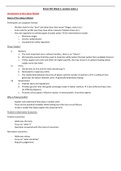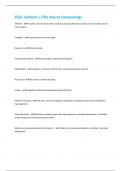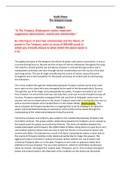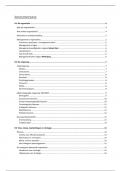Introduction to the Labour Market
Basics of the Labour Market
Participants are assigned motives:
- Workers look for the “best” job (what does that mean? Wages, status etc.)
- Firms look for profits (can they have other interests? Market share etc.)
- Gvt uses regulation to achieve goals of public policy → Gvt interventions include:
o Minimum wages
o Income redistribution
o Occupational safety regulation
Three “Actors”
i) Workers
a. The most important actor: without workers, there is no “labour”
b. We typically assume that they seek to maximize utility (select the best option from available choices)
c. If they supply more time and effort for higher payoffs, this may result in an upward sloping labour
supply curve (see later)
ii) Firms
a. Decide who to hire and fire (who decides pay?)
b. Motivated to maximize profits
c. The relationship between the price of labour and the number of workers a firm is willing to hire
generates the labour demand curve → generally downward sloping
iii) Government
a. Imposes taxes and regulations
b. Provides ground rules that guide exchanges made in labour markets → it also enforces these rules
(to differing degrees)
c. Promote various goals: influence equity, increase growth, incentivize agents
Why is Theory Useful?
- Explain and understand how labour markets work
- Focus on the essential variables while leaving out other less crucial factors
- Create a model that helps explain the empirical facts
Positive vs Normative Economics
Positive economics:
- Addresses the facts
- Focus on “what is”
- Questions answered with the tools of economics
Normative economics:
- Addresses values
- Focus on “what should be”
- Requires judgements
,Example: Trans-Alaska Oil Pipeline
What follows is mostly a short summary from Borjas’ book of Carrington (Journal of Political Economy 1996)
- In 1968, a giant oilfield was discovered in Prudhoe Bay in remote northern Alaska
- To transport the oil to consumers, firms decided to build a pipeline over 1200km long to the ice-free port of
Valdez and ship the oil from there in tankers
- The pipeline was eventually constructed from 1974-1977
o Why the timing? Right after the oil price shock of 1973
How can we think about its labour market implications?
Supply and Demand in the Engineering Labour Market
- How do workers, firms and gvt shape the labour market equilibrium
according to this diagram?
o Workers determine supply-side
o Firms determine demand-side
o Gvt sets ground rules
- What assumptions are made in this diagram?
o Downward-sloping labour demand curve
o Upward-sloping labour supply curve
The Alaskan Labour Market and Construction of the Oil Pipeline
- What do you expect to happen when the construction project starts?
o Firms need more workers in short-run, hence demand curve shifts
to the right
o Thus, both wages and employment rise
- What might happen when construction ends?
o We’d expect a lot of it to be reversed back, with less demand now
needed so wages and employment fall
Wages and Employment in the Alaskan Labour Market, 1968-1984
However, as expected, the model is too simple. Let’s look at the data:
- Wages increase sharply from 1973-1977
- Wages then fell as expected post-1977, although
interestingly it didn’t fall down to the initial level
- Even more interesting is that employment rose, and then
barely fell, instead actually rising into the 80s
- Where did the increase in labour supply come from?
o A lot of it came from new workers relocating to
Alaska, and then not moving back
- Note the tooth-shaped nature of the lines → there seems to
be seasonality, so summer months have more workers
Regression Analysis
Suppose we wanted to look at a model where wages increase linearly with
years of schooling.
Does it make sense to use log wages or wages in levels?
- Wages will always be positive, so we can take logs of wages, as it
makes regression nicer
- However, if we use e.g. hours, then it’s trickier because we’d disregard
a lot of observations (e.g. at 0 hours)
,Scatter Diagram: Wages and Schooling by Occupation, 2001
- We see a positive correlation between years of schooling and
log wages
- This lines up quite well with the theoretical idea that log wages
increase roughly linearly with years of schooling
How do we make sense of this diagram? We’d want to fit a line, but
there’s many lines we could use (e.g. 𝐴, 𝐵 or 𝐶)
‘Best-Fit’ Regression Line
Thus, we use regression to find the ‘best-fit’ line:
𝐿𝑜𝑔 𝑊𝑎𝑔𝑒 = 𝛽(𝑌𝑒𝑎𝑟𝑠 𝑜𝑓 𝑆𝑐ℎ𝑜𝑜𝑙𝑖𝑛𝑔) + 𝜀
where 𝛽 is estimated with minimum squares (OLS)
However, note that we don’t necessarily have to use OLS.
Also, we might want to consider specific points. For example, the point
representing teachers is quite far out from the line.
Why do teachers have lower wages relative to their years of schooling?
- Perhaps the demand for teachers is mostly coming from the public sector
- Perhaps teachers are intrinsically motivated
- Maybe there’s more important factors such as work-life balance
Regression with Covariates
We can extend regression analysis to include multiple independent variables:
𝐿𝑜𝑔 𝑊𝑎𝑔𝑒 = 𝛽(𝑌𝑒𝑎𝑟𝑠 𝑜𝑓 𝑆𝑐ℎ𝑜𝑜𝑙𝑖𝑛𝑔) + 𝛾𝑋 + 𝜀
- Each estimated coefficient shows how the LHS variable varies when the RHS variable changes, controlling for
the others
- Standard errors of the regression coefficients are used to evaluate the significance of the relations between
each particular variable and the dependent variable
Causality
Does 𝛽 represent the causal effect of schooling on wages? In most cases, the answer is no.
Years of schooling might be correlated with 𝜀 (e.g. ability → high-ability individuals’ study more and earn more). Can
we control for ability?
Various econometric solutions: randomized experiments, natural experiments.
Changes Over Time: US Labour Markets in 20th Century
No particular reason to focus on the US, but it’s the largest economy and for many years mirrored or anticipated
(some of) the changes later experienced elsewhere in the world.
Here, we summarize some of the changes that have taken place in labour markets over the 20th century (Goldin
1994).
, Changes in real earnings:
- Increased by factor of about 4 from 1900-1990:
exp(10.15)
exp(8.75)
≈4
- Why might this growth have happened?
o Technological change
Labour productivity index:
- Increased by factor of about 6 from 1890-1990:
exp(5.07)
≈6
exp(3.27)
- Steeper increase than real earnings
- Why?
o Technological change
o Accumulation of capital
Weekly work hours:
- Over time, full-time work has become shorter
- In the 1800s, weekly hours were 60-70 hours, and has fallen to 40-45
in the 1990s
- Different lines due to different sources, but the general downward
trend is quite clear
Labour force participation of “prime-age” men and women:
- Historically, the prime-age was 25-44 (note now it’s probably quite a
bit longer than that)
- Male labour force participation rate has remained very high but
quite stagnant
- Female labour force participation has gradually increased and has
been catching up to males, but isn’t quite there yet
Union membership as fraction of non-agricultural employment:
- Around 1900, early-start of unions, but they didn’t really catch on
until the 1930-40s
- Gvt played an important role in the rise of unions around that time,
but then also played an important role in the fall across the 1970-90s
- However, we see that the private sector unions have fallen more
dramatically than the public sector











